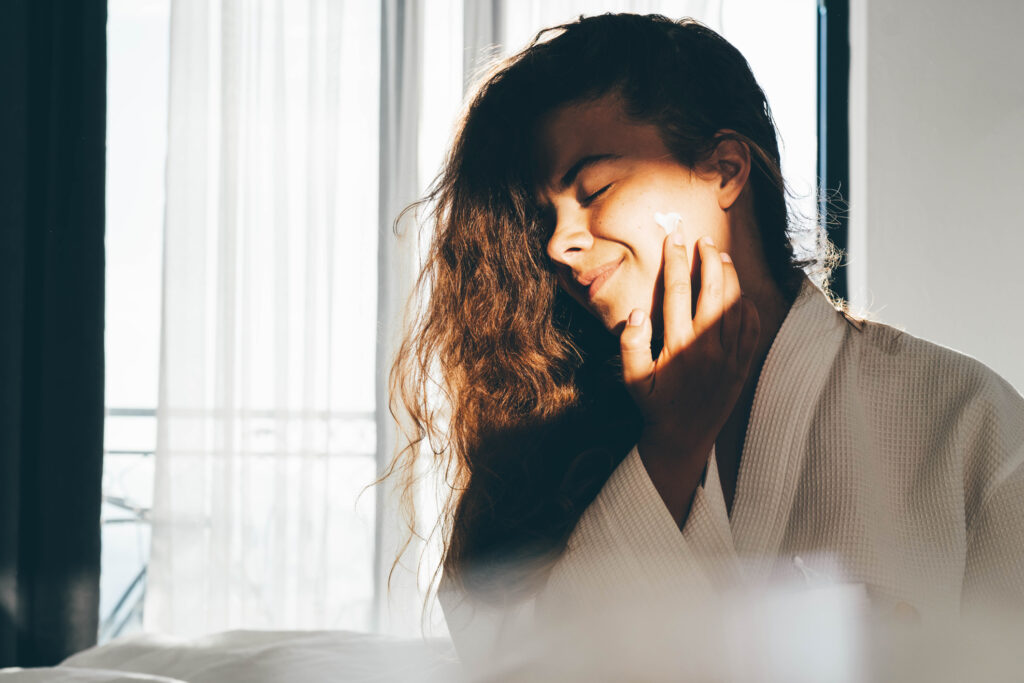A beauty routine is a great way to express style and individuality. Some people like to experiment with bright makeup, some like a classic look and others prefer to stay as natural as possible. There’s one beauty goal that’s nearly universal, however: a refreshed, glowing complexion. Nothing signifies health like radiant skin, and a great complexion is the best foundation for any look — whether you’re going low-key or getting glammed up for a night on the town.
With so many cleansers, creams and serums out there, it can be tough to know which products to use (and how to use them) to achieve that enviably luminous skin tone. Here’s our step-by-step guide for getting your healthiest skin yet.
Step One: Ditch Indoor Tanning!
Your skin will never get a chance to show off its natural radiance if ultraviolet (UV) radiation emitted by indoor tanning devices are damaging it. Though many women desire a bronzed look, especially in the summer months, the damage done to your skin simply isn’t worth it. Not only does indoor tanning drastically increase your chances of developing skin cancer —using a tanning bed before the age of 35 increases your risk of melanoma by 75 percent —it also contributes to undesirable aesthetic changes in the skin. Wrinkles, dark spots and other signs of skin aging are an unavoidable consequence of tanning and will definitely get in the way of a bright, youthful complexion.
Can’t resist a tanned look? Sunless tanning options, including sprays, lotions and wipes, are the way to go. Just keep in mind that sunless tanning products typically don’t provide sun protection.
Sign the Petition: Tell the FDA to Ban Teen Tanning
Step Two: Protect Against Sun Damage
Though the indoor tanning bed is an express track to skin damage, everyday exposure to the sun’s UV rays also damages your skin. Protecting yourself from the sun every day, all year long, is key. It lowers your risk of skin cancer and keeps your skin from breaking down, since the sun causes about 80 percent of visible skin aging. A complete sun protection regimen can help avoid premature aging, so try to seek shade between 10 AM and 4 PM (when the sun’s rays are strongest), cover up with clothing, including a broad-brimmed hat and UV-blocking sunglasses, and use a broad-spectrum sunscreen with an SPF of at least 30. One study found that people who use SPF 30 or higher sunscreen every day show 24 percent less skin aging than those who skip sunscreen.
Step Three: Make Friends with Your Dermatologist
Do you see a dermatologist once a year for a full-body skin exam? If not, make your appointment ASAP! In addition to carefully checking your skin for signs of skin cancer, your dermatologist can answer any questions you have about your skin and make recommendations for products that would work best for your skin type.
Step Four: Perfect Your Daily Routine
Cleansing your face, both morning and night, is a must for glowing skin. Choose formulas that work best for your skin type and beauty routine. You might find that using two products suits you — for example, a mild, gentle cleanser in the morning, and a stronger formula at night to remove makeup.
In the mornings, consider adding a vitamin C serum to your routine. Vitamin C is both an antioxidant and beneficial for collagen production and maintenance, so it can help reduce wrinkles and create an even skin tone. Next up is moisturizer, preferably one with sunscreen ingredients (otherwise, you’ll need to apply a separate sunscreen first). Cosmetics should be your last step. Apart from sunless tanners, bronzers and blushes are a great way to get a little color on your face without sustaining UV damage.
As for your evening cleansing routine, if you like to exfoliate, now is the time. Certain exfoliating products can make the skin more sensitive to sunlight, so it’s best to use them at night. Limit exfoliating to just once or twice a week, depending on your skin type.
Another option for your nighttime routine is a product containing retinoids. These ingredients are derived from vitamin A and can help your skin shed damaged skin layers and rebuild collagen – the protein that gives your skin elasticity. Some people find their skin is highly sensitive to vitamin A, so it’s not for everyone. If you do choose to use a retinoid, use it sparingly. A dime-sized amount will do, once or twice a week. Last, but not least, apply your nighttime moisturizer.
Now what are you waiting for? Get Glowing!





